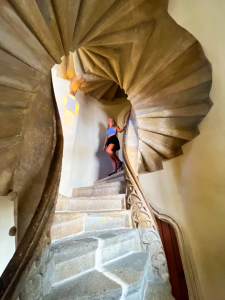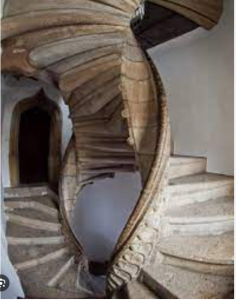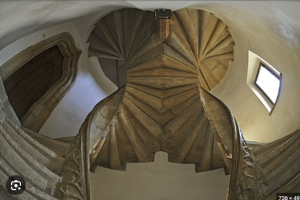A Dance of Wood and Stone
In the heart of the Burg of Graz, Austria, lies an architectural marvel that has captivated visitors and scholars alike for centuries: the double spiral staircase known as the “staircase of reconciliation.” Crafted in 1499, this unique structure embodies a blend of beauty, precision, and symbolism. It stands not only as a testament to the ingenuity of its creators but also as a metaphor for the complex nature of human relationships. This blog post explores the historical and architectural significance of this staircase, inviting readers to envision its grandeur and ponder its deeper meanings.

A Masterpiece of Design and Craftsmanship
The double spiral staircase in Graz is an exemplary showcase of late Gothic architecture. Its design features two opposing stairways that intertwine yet maintain their separate paths, briefly merging on each floor before parting ways again. This ingenious construction was not only a feat of architectural skill but also a deliberate expression of the reconciliation theme. Each step and turn encapsulates the idea that individuals, or perhaps opposing forces, can come together, diverge, and then reunite in harmony. The meticulous craftsmanship and enduring materials have preserved its beauty and functionality, allowing it to withstand the test of time.

Symbolism and Functionality Intertwined
Beyond its architectural appeal, the “staircase of reconciliation” is imbued with profound symbolism. It reflects the human journey, characterized by conflicts and resolutions, separations, and reunions. The staircase serves as a reminder that, despite differences, there is always a path to come back together, a poignant message in any era. Additionally, its practical design facilitated the flow of traffic within the Burg, illustrating how form and function can coexist seamlessly. The staircase became a central feature of the castle, embodying both the literal and figurative heart of the structure.

The Burg of Graz: A Historic Setting
The Burg of Graz, with its rich history and architectural diversity, provides the perfect backdrop for the staircase. Built in the 15th century, the castle has witnessed numerous historical events and transformations, serving various roles from a residence of royalty to a center of administration. The staircase, located within this historic complex, adds to the allure of the Burg, drawing visitors not only for its aesthetic beauty but also for the stories and secrets it holds. Its presence enhances the castle’s architectural narrative, contributing to its status as a cultural and historical landmark.

Ancient Discoveries and Modern Reflections
The “staircase of reconciliation” in Graz stands as a bridge between the past and the present, reminding us of the timeless nature of art and architecture. Just as ancient discoveries shed light on the civilizations that came before us, modern architectural wonders like this staircase invite us to reflect on our current values and visions. It underscores the importance of balance, unity, and the enduring human spirit in the face of adversity. In a world often divided, the staircase serves as a symbol of the potential for reconciliation and the beauty that arises when diverse paths converge.

Conclusion: A Legacy Carved in Stone
The double spiral staircase of the Burg of Graz is more than just an architectural achievement; it is a symbol of hope, unity, and the enduring human capacity for reconciliation. As we marvel at its intricate design and delve into its historical context, we are reminded of the power of architecture to convey profound messages and inspire reflection. The staircase encourages us to consider our own paths, the intersections we face, and the possibilities that lie in coming together after a separation. In its silent, spiraling form, it speaks volumes about the journey of life, the art of compromise, and the timeless quest for harmony.



